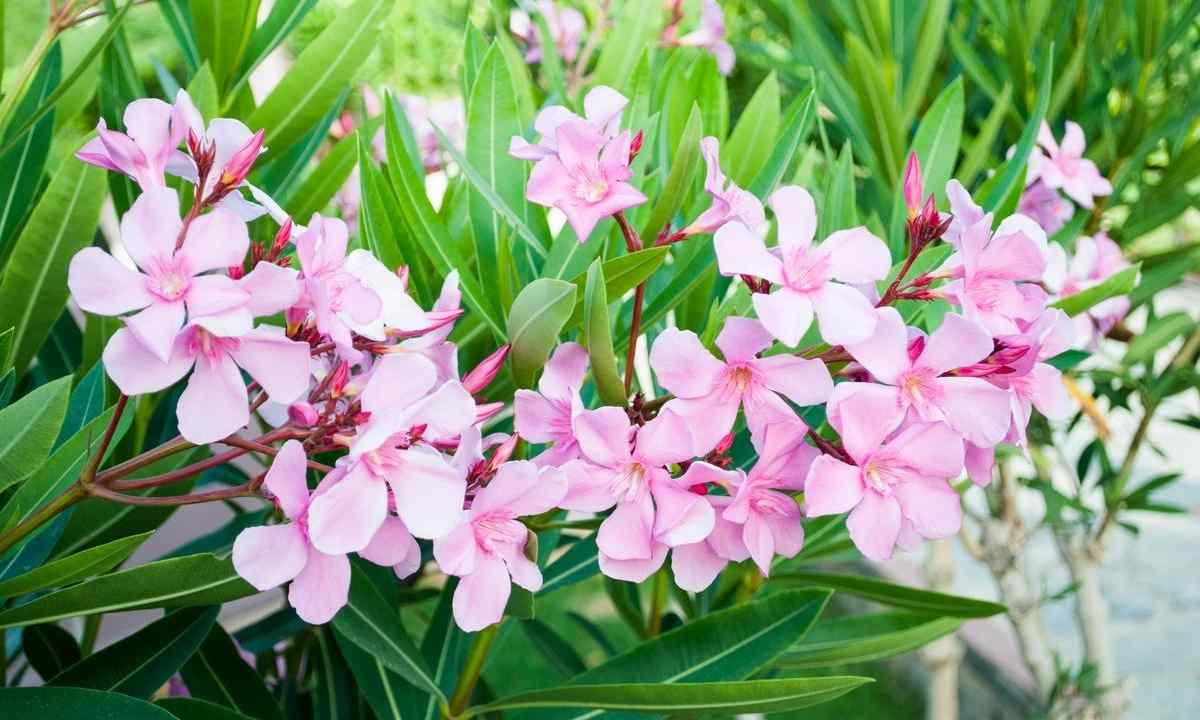These refined flowers and their fragrance of very few people will leave indifferent. Fans of houseplants and landscaping with pleasure grow up oleander. Cultivating the fragrant blossoming bushes, it is impossible to forget: the plant is poisonous, during the work with it the care is necessary.
Poisonous beauty
Scientists have proved: juice of oleander contains the warm glikozita dangerous to work of heart and central nervous system. If accidentally or intentionally to eat any part of plant, especially to use fresh juice, consequences can be various - from vomiting and indigestion to cardiac arrest.
For this reason it is impossible to decorate with beautiful, but artful plant interior of child care facilities – kids drag everything in mouth. The adult has to work with oleander in gloves, not allow hit of juice on mucous, and protection is necessary even when cleaning dry parts of bush.
At observance of safety precautions it is possible to grow up plant and it is even necessary, it is really attractive: leathery lantsetny leaves, difficult inflorescences of various palette from white to purple, gentle aroma of almonds and vanilya... However if somewhere in the Mediterranean, special conditions of cultivation are not necessary for oleander, then inhabitants of midland should try.
Oleander for your garden
Garden forms of oleander vary on coloring of flowers, makhrovost, smell. The plant pleases with violent blossoming all summer. Usually in midland the oleander is grown up in pots, winter gardens, greenhouses at home or exposed in containers on open air in the hot summer, and cleans up in the winter. The plant does not take out frosts.
In garden at skilled summer residents, in particular, the following grades of oleander successfully blossom:
- Double White with large white colors with lobes of round shape;
- Can-Can – bright crimson;
- Double Pink – dark pink, terry;
- Soleil Levant – single, gentle-pink with the yellow center;
- Hardyred – with red fragrant flowers of mean value;
- Scarlett crimson and scarlet terry.
How to grow up oleander
It is the simplest to grow up oleander by cherenkovaniye. For this purpose in the spring from mature and healthy maternal bush it is necessary to cut off the lignified branches 15-20 cm long, to truncate foliage below and to cut unripe vershinka. To place shanks for 2 weeks in glass containers with water far from direct sunshine.
It is recommended to add wood charcoal in order to avoid rotting of planting stock to vessel. After emergence of small backs the saplings should be replaced in containers with the earth.
To couch mature seeds of oleander, they need to be killed in gentle-pink solution of potassium permanganate, then several hours to take in warm water and to seed in the moistened mix of wood charcoal, sand and vermiculite. For this purpose it is necessary to use containers with drainage holes.
Good lighting and temperature 30-35os are necessary for emergence of sprouts therefore additional illumination and heat can be necessary. When sprouts grow to 2-3 leaves, temperature can be below. Crops should be replaced in spacious tanks for carrying out in garden.
Landing of oleander to the constant place to the open ground is possible if the region does not differ in severe winters with frosts below - 9 wasps. But also then in cold time the plant needs warming. To put oleander or to expose, trenching in containers, it is possible only on sunny South side of the site.
Basic rules of care for oleander
- Optimum soil for oleander – mix of sand, peat, humus, the sheet and cespitose soil. To put to the open ground or to take out in garden of plant it is possible in April, or to expose on the southern terraces and loggias.
- During heat and the period of drought flowers need abundant watering 3-4 times a week.
- For forming of beautiful bush the oleander of times in 3 years can be cut off strongly in the second half of summer season. Optimum length of floriferous escape – 30 cm. Every season deflowered flowers and tips of stalks need to be cut off that the bush in the future branched better.
- Mineral and organic fertilizing moves to bushes approximately once a half-month. Under the lower branches of oleander compost around spreads. Within the first 3-4 years of cultivation of plant on the poor soil it is recommended to bring complex phosphorus-potassium-nitrogen fertilizer on spring.
- Most often the plant is attacked by caterpillars of brazhnik, plant louse, shchitovka, mealy worm, web tick. At the first signs of defeat of bush wreckers it is necessary to process it special means, carefully carrying out the instruction on packing.
- At the beginning of season it is necessary to mulch beds on 5 cm, for example, wood chips, previously having removed old mulch.

